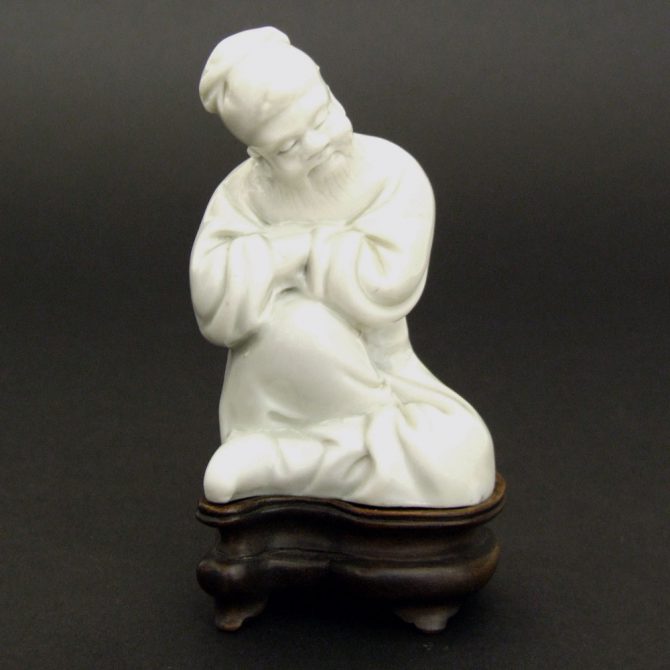
CHONGZHEN 1628 – 1644 Blanc de Chine Porcelain
A Fine Late Ming Blanc de Chine Porcelain Model of the Tang Dynasty Poet Li Bai, Dehua Kilns, Fujian Province, Ming Dynasty, Chongzhen Period 1628 – 1644. The Model is Heavily Potted with a Lot of Hand- Tooling, the Glaze is a Warm Cream Colour.
SOLD
- Condition
- Perfect, with a later wood stand.
- Size
- Height (excluding the stand) : 8.2 cm (3 1/4 inches).
- Provenance
- An old collection label on the back of the figure states that it is "Kang Hsi Period 1662 - 1723 A.D.".
- Stock number
- 22429
Information
Li Bai / Li Bo :
The Tang dynasty Taoist poet Li Bai, sometimes transliterated as Li Bo, lived from 701 to 762. He is considered the best of the `Romantic Poets` in an age of great poetry, a period often referred to as the golden age of Chinese poetry. His personality fascinated aristocrats and common people alike, Li Bai even meet the emperor. Another Taoist and poet, He Zhizhang, bestowed upon him the nickname "the Transcendent dismissed from the Heaven". Many of the Classical Chinese poets were associated with drinking wine, or more precisely, alcoholic beverages. In fact, Li Bai was part of the group of Chinese scholars during his time in Chang`an, called the "Eight Immortals of the Wine Cup", as mentioned in a poem by fellow poet Du Fu. However, Li Bai is of special note in this respect. As Burton Watson put it, "early all Chinese poets celebrate the joys of wine, but none so tirelessly and with such a note of genuine conviction as Li [Bai]", Or as John C. H. Wu put it, "while some may have drunk more wine than Li [Bai], no one has written more poems about wine." Due to his championship of drunkenness together with his wandering life-style, Li Bai`s poetry has been criticized on moral grounds. But it is as the learned drunken poet that he is depicted in Chinese ceramics, his image has been produced in blanc de chine and Famille Verte as figures, often shown sound asleep next to an empty wine barrel. This image also occurs painted on Kangxi porcelain. The information here is from an article on wikipedia, it has been abridged and adapted, as well as added too.
http://en.wikipedia.org/wiki/Li_Bai
Blanc de Chine Porcelain :
The porcelain known in the West as Blanc de Chine was produced 300 miles south of the main Chinese kiln complex of Jingdezhen. The term refers to the fine grain white porcelain made at the kilns situated near Dehua in the coastal province of Fujian, these kilns also produced other types of porcelain. A rather freely painted blue and white ware, porcelain with brightly coloured `Swatow` type enamels as well as pieces with a brown iron-rich glaze. However, it is the white Blanc de Chine wares that have made these kilns famous. The quality and colour achieved by the Dehua potters was partly due to the local porcelain-stone, it was unusually pure and was used without kaolin being added. This, combined with a low iron content and other chemical factors within the body, as well as the glaze, enabled the potters to produce superb ivory-white porcelain. White porcelain was made at the Dehua kilns from early times, some books refer to the white porcelain produced during the Yuan period as being Blanc de Chine, but I think it is not really until the latter stages of the Ming dynasty, during the late 16th century, that a porcelain with clearly recognisable Blanc de Chine characteristics was produced. There is a theory that there was a brake in production during a large part of the 18th century. I am highly sceptical of this, it seams likely that Blanc de Chine porcelain was made all the way through, uninterrupted from the Ming dynasty to the present day.



